Peilin Zhou
Hong Kong University of Science and Technology
What Matters in LLM-Based Feature Extractor for Recommender? A Systematic Analysis of Prompts, Models, and Adaptation
Sep 18, 2025Abstract:Using Large Language Models (LLMs) to generate semantic features has been demonstrated as a powerful paradigm for enhancing Sequential Recommender Systems (SRS). This typically involves three stages: processing item text, extracting features with LLMs, and adapting them for downstream models. However, existing methods vary widely in prompting, architecture, and adaptation strategies, making it difficult to fairly compare design choices and identify what truly drives performance. In this work, we propose RecXplore, a modular analytical framework that decomposes the LLM-as-feature-extractor pipeline into four modules: data processing, semantic feature extraction, feature adaptation, and sequential modeling. Instead of proposing new techniques, RecXplore revisits and organizes established methods, enabling systematic exploration of each module in isolation. Experiments on four public datasets show that simply combining the best designs from existing techniques without exhaustive search yields up to 18.7% relative improvement in NDCG@5 and 12.7% in HR@5 over strong baselines. These results underscore the utility of modular benchmarking for identifying effective design patterns and promoting standardized research in LLM-enhanced recommendation.
DeKeyNLU: Enhancing Natural Language to SQL Generation through Task Decomposition and Keyword Extraction
Sep 18, 2025Abstract:Natural Language to SQL (NL2SQL) provides a new model-centric paradigm that simplifies database access for non-technical users by converting natural language queries into SQL commands. Recent advancements, particularly those integrating Retrieval-Augmented Generation (RAG) and Chain-of-Thought (CoT) reasoning, have made significant strides in enhancing NL2SQL performance. However, challenges such as inaccurate task decomposition and keyword extraction by LLMs remain major bottlenecks, often leading to errors in SQL generation. While existing datasets aim to mitigate these issues by fine-tuning models, they struggle with over-fragmentation of tasks and lack of domain-specific keyword annotations, limiting their effectiveness. To address these limitations, we present DeKeyNLU, a novel dataset which contains 1,500 meticulously annotated QA pairs aimed at refining task decomposition and enhancing keyword extraction precision for the RAG pipeline. Fine-tuned with DeKeyNLU, we propose DeKeySQL, a RAG-based NL2SQL pipeline that employs three distinct modules for user question understanding, entity retrieval, and generation to improve SQL generation accuracy. We benchmarked multiple model configurations within DeKeySQL RAG pipeline. Experimental results demonstrate that fine-tuning with DeKeyNLU significantly improves SQL generation accuracy on both BIRD (62.31% to 69.10%) and Spider (84.2% to 88.7%) dev datasets.
From Web Search towards Agentic Deep Research: Incentivizing Search with Reasoning Agents
Jun 23, 2025Abstract:Information retrieval is a cornerstone of modern knowledge acquisition, enabling billions of queries each day across diverse domains. However, traditional keyword-based search engines are increasingly inadequate for handling complex, multi-step information needs. Our position is that Large Language Models (LLMs), endowed with reasoning and agentic capabilities, are ushering in a new paradigm termed Agentic Deep Research. These systems transcend conventional information search techniques by tightly integrating autonomous reasoning, iterative retrieval, and information synthesis into a dynamic feedback loop. We trace the evolution from static web search to interactive, agent-based systems that plan, explore, and learn. We also introduce a test-time scaling law to formalize the impact of computational depth on reasoning and search. Supported by benchmark results and the rise of open-source implementations, we demonstrate that Agentic Deep Research not only significantly outperforms existing approaches, but is also poised to become the dominant paradigm for future information seeking. All the related resources, including industry products, research papers, benchmark datasets, and open-source implementations, are collected for the community in https://github.com/DavidZWZ/Awesome-Deep-Research.
Compliance-to-Code: Enhancing Financial Compliance Checking via Code Generation
May 26, 2025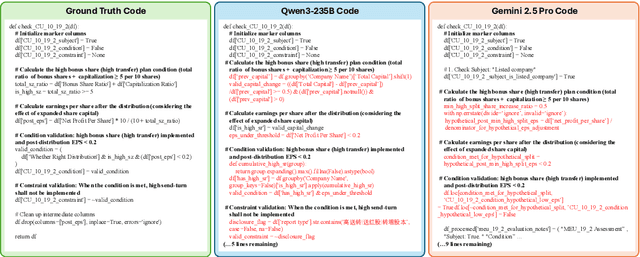
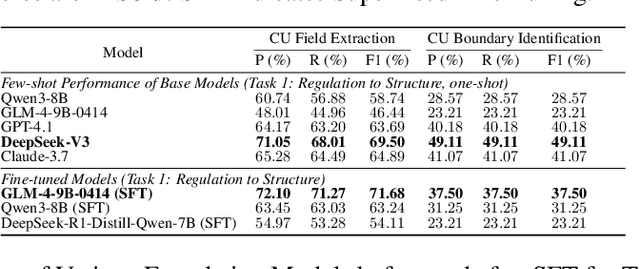


Abstract:Nowadays, regulatory compliance has become a cornerstone of corporate governance, ensuring adherence to systematic legal frameworks. At its core, financial regulations often comprise highly intricate provisions, layered logical structures, and numerous exceptions, which inevitably result in labor-intensive or comprehension challenges. To mitigate this, recent Regulatory Technology (RegTech) and Large Language Models (LLMs) have gained significant attention in automating the conversion of regulatory text into executable compliance logic. However, their performance remains suboptimal particularly when applied to Chinese-language financial regulations, due to three key limitations: (1) incomplete domain-specific knowledge representation, (2) insufficient hierarchical reasoning capabilities, and (3) failure to maintain temporal and logical coherence. One promising solution is to develop a domain specific and code-oriented datasets for model training. Existing datasets such as LexGLUE, LegalBench, and CODE-ACCORD are often English-focused, domain-mismatched, or lack fine-grained granularity for compliance code generation. To fill these gaps, we present Compliance-to-Code, the first large-scale Chinese dataset dedicated to financial regulatory compliance. Covering 1,159 annotated clauses from 361 regulations across ten categories, each clause is modularly structured with four logical elements-subject, condition, constraint, and contextual information-along with regulation relations. We provide deterministic Python code mappings, detailed code reasoning, and code explanations to facilitate automated auditing. To demonstrate utility, we present FinCheck: a pipeline for regulation structuring, code generation, and report generation.
BrowseComp-ZH: Benchmarking Web Browsing Ability of Large Language Models in Chinese
May 01, 2025Abstract:As large language models (LLMs) evolve into tool-using agents, the ability to browse the web in real-time has become a critical yardstick for measuring their reasoning and retrieval competence. Existing benchmarks such as BrowseComp concentrate on English and overlook the linguistic, infrastructural, and censorship-related complexities of other major information ecosystems -- most notably Chinese. To address this gap, we introduce BrowseComp-ZH, a high-difficulty benchmark purpose-built to comprehensively evaluate LLM agents on the Chinese web. BrowseComp-ZH consists of 289 multi-hop questions spanning 11 diverse domains. Each question is reverse-engineered from a short, objective, and easily verifiable answer (e.g., a date, number, or proper noun). A two-stage quality control protocol is applied to strive for high question difficulty and answer uniqueness. We benchmark over 20 state-of-the-art language models and agentic search systems on our proposed BrowseComp-ZH. Despite their strong conversational and retrieval capabilities, most models struggle severely: a large number achieve accuracy rates below 10%, and only a handful exceed 20%. Even the best-performing system, OpenAI's DeepResearch, reaches just 42.9%. These results demonstrate the considerable difficulty of BrowseComp-ZH, where success demands not only effective retrieval strategies, but also sophisticated reasoning and information reconciliation -- capabilities that current models still struggle to master. Our dataset, construction guidelines, and benchmark results have been publicly released at https://github.com/PALIN2018/BrowseComp-ZH.
Cold-Start Recommendation towards the Era of Large Language Models (LLMs): A Comprehensive Survey and Roadmap
Jan 03, 2025Abstract:Cold-start problem is one of the long-standing challenges in recommender systems, focusing on accurately modeling new or interaction-limited users or items to provide better recommendations. Due to the diversification of internet platforms and the exponential growth of users and items, the importance of cold-start recommendation (CSR) is becoming increasingly evident. At the same time, large language models (LLMs) have achieved tremendous success and possess strong capabilities in modeling user and item information, providing new potential for cold-start recommendations. However, the research community on CSR still lacks a comprehensive review and reflection in this field. Based on this, in this paper, we stand in the context of the era of large language models and provide a comprehensive review and discussion on the roadmap, related literature, and future directions of CSR. Specifically, we have conducted an exploration of the development path of how existing CSR utilizes information, from content features, graph relations, and domain information, to the world knowledge possessed by large language models, aiming to provide new insights for both the research and industrial communities on CSR. Related resources of cold-start recommendations are collected and continuously updated for the community in https://github.com/YuanchenBei/Awesome-Cold-Start-Recommendation.
CellSeg1: Robust Cell Segmentation with One Training Image
Dec 02, 2024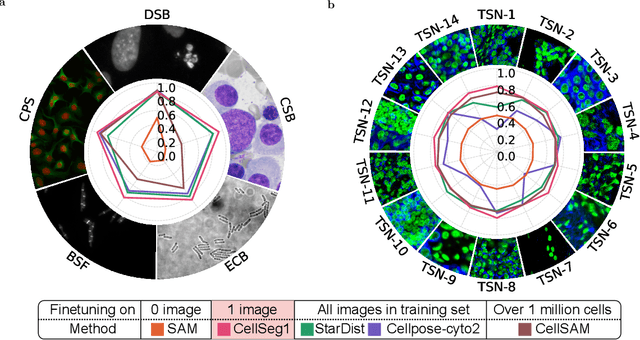
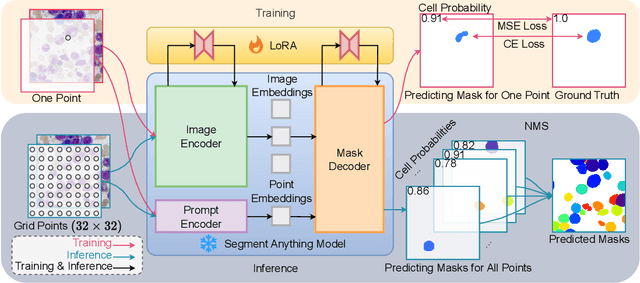
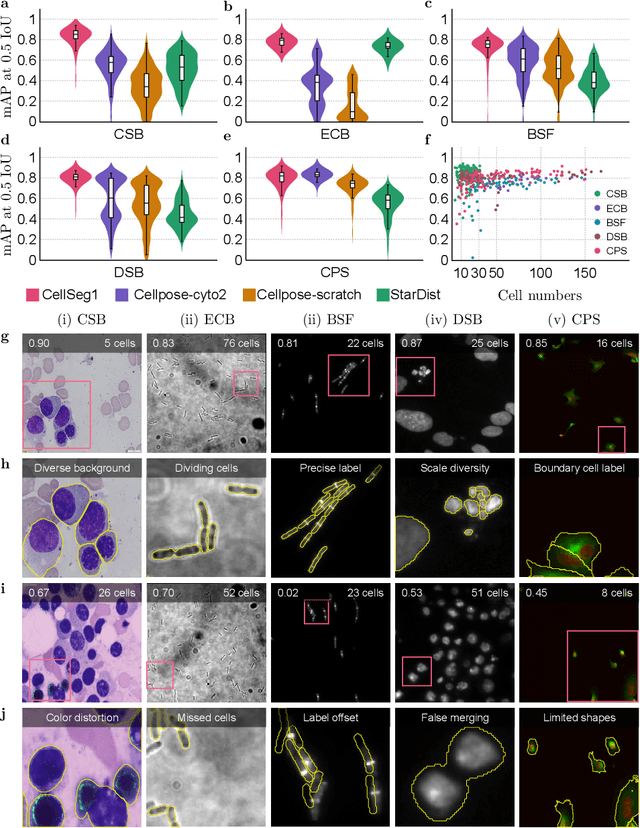
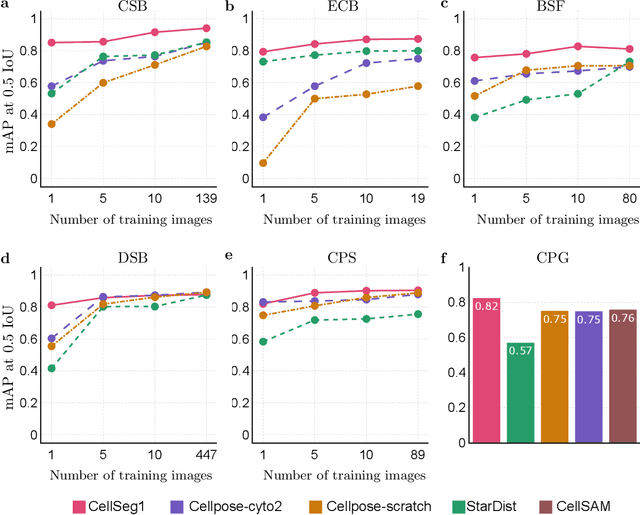
Abstract:Recent trends in cell segmentation have shifted towards universal models to handle diverse cell morphologies and imaging modalities. However, for continuously emerging cell types and imaging techniques, these models still require hundreds or thousands of annotated cells for fine-tuning. We introduce CellSeg1, a practical solution for segmenting cells of arbitrary morphology and modality with a few dozen cell annotations in 1 image. By adopting Low-Rank Adaptation of the Segment Anything Model (SAM), we achieve robust cell segmentation. Tested on 19 diverse cell datasets, CellSeg1 trained on 1 image achieved 0.81 average mAP at 0.5 IoU, performing comparably to existing models trained on over 500 images. It also demonstrated superior generalization in cross-dataset tests on TissueNet. We found that high-quality annotation of a few dozen densely packed cells of varied sizes is key to effective segmentation. CellSeg1 provides an efficient solution for cell segmentation with minimal annotation effort.
FinTruthQA: A Benchmark Dataset for Evaluating the Quality of Financial Information Disclosure
Jun 17, 2024Abstract:Accurate and transparent financial information disclosure is crucial in the fields of accounting and finance, ensuring market efficiency and investor confidence. Among many information disclosure platforms, the Chinese stock exchanges' investor interactive platform provides a novel and interactive way for listed firms to disclose information of interest to investors through an online question-and-answer (Q&A) format. However, it is common for listed firms to respond to questions with limited or no substantive information, and automatically evaluating the quality of financial information disclosure on large amounts of Q&A pairs is challenging. This paper builds a benchmark FinTruthQA, that can evaluate advanced natural language processing (NLP) techniques for the automatic quality assessment of information disclosure in financial Q&A data. FinTruthQA comprises 6,000 real-world financial Q&A entries and each Q&A was manually annotated based on four conceptual dimensions of accounting. We benchmarked various NLP techniques on FinTruthQA, including statistical machine learning models, pre-trained language model and their fine-tuned versions, as well as the large language model GPT-4. Experiments showed that existing NLP models have strong predictive ability for real question identification and question relevance tasks, but are suboptimal for answer relevance and answer readability tasks. By establishing this benchmark, we provide a robust foundation for the automatic evaluation of information disclosure, significantly enhancing the transparency and quality of financial reporting. FinTruthQA can be used by auditors, regulators, and financial analysts for real-time monitoring and data-driven decision-making, as well as by researchers for advanced studies in accounting and finance, ultimately fostering greater trust and efficiency in the financial markets.
Vision-Language Models Meet Meteorology: Developing Models for Extreme Weather Events Detection with Heatmaps
Jun 14, 2024



Abstract:Real-time detection and prediction of extreme weather protect human lives and infrastructure. Traditional methods rely on numerical threshold setting and manual interpretation of weather heatmaps with Geographic Information Systems (GIS), which can be slow and error-prone. Our research redefines Extreme Weather Events Detection (EWED) by framing it as a Visual Question Answering (VQA) problem, thereby introducing a more precise and automated solution. Leveraging Vision-Language Models (VLM) to simultaneously process visual and textual data, we offer an effective aid to enhance the analysis process of weather heatmaps. Our initial assessment of general-purpose VLMs (e.g., GPT-4-Vision) on EWED revealed poor performance, characterized by low accuracy and frequent hallucinations due to inadequate color differentiation and insufficient meteorological knowledge. To address these challenges, we introduce ClimateIQA, the first meteorological VQA dataset, which includes 8,760 wind gust heatmaps and 254,040 question-answer pairs covering four question types, both generated from the latest climate reanalysis data. We also propose Sparse Position and Outline Tracking (SPOT), an innovative technique that leverages OpenCV and K-Means clustering to capture and depict color contours in heatmaps, providing ClimateIQA with more accurate color spatial location information. Finally, we present Climate-Zoo, the first meteorological VLM collection, which adapts VLMs to meteorological applications using the ClimateIQA dataset. Experiment results demonstrate that models from Climate-Zoo substantially outperform state-of-the-art general VLMs, achieving an accuracy increase from 0% to over 90% in EWED verification. The datasets and models in this study are publicly available for future climate science research: https://github.com/AlexJJJChen/Climate-Zoo.
FinTextQA: A Dataset for Long-form Financial Question Answering
May 16, 2024



Abstract:Accurate evaluation of financial question answering (QA) systems necessitates a comprehensive dataset encompassing diverse question types and contexts. However, current financial QA datasets lack scope diversity and question complexity. This work introduces FinTextQA, a novel dataset for long-form question answering (LFQA) in finance. FinTextQA comprises 1,262 high-quality, source-attributed QA pairs extracted and selected from finance textbooks and government agency websites.Moreover, we developed a Retrieval-Augmented Generation (RAG)-based LFQA system, comprising an embedder, retriever, reranker, and generator. A multi-faceted evaluation approach, including human ranking, automatic metrics, and GPT-4 scoring, was employed to benchmark the performance of different LFQA system configurations under heightened noisy conditions. The results indicate that: (1) Among all compared generators, Baichuan2-7B competes closely with GPT-3.5-turbo in accuracy score; (2) The most effective system configuration on our dataset involved setting the embedder, retriever, reranker, and generator as Ada2, Automated Merged Retrieval, Bge-Reranker-Base, and Baichuan2-7B, respectively; (3) models are less susceptible to noise after the length of contexts reaching a specific threshold.
 Add to Chrome
Add to Chrome Add to Firefox
Add to Firefox Add to Edge
Add to Edge